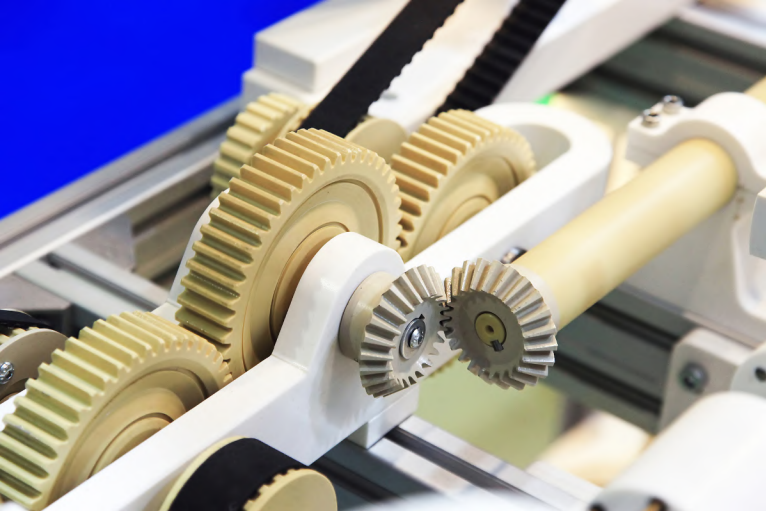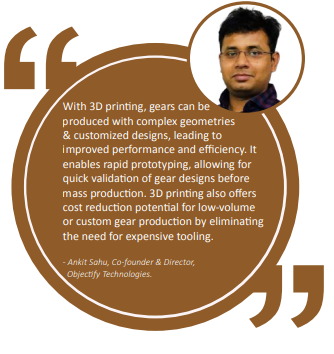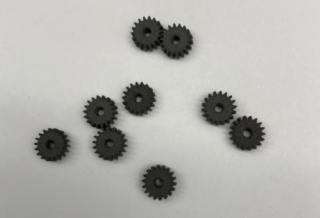The Impact of 3D Printing in Gear Manufacturing
Author Gear Technology India on June 19, 2023
By eliminating the need for traditional tooling and machining processes, 3D printing streamlines production and reduces lead times, making it an attractive option for various industries
By: Nishant Kashyap
Gear manufacturing has long been a critical component of various industries ranging from automotive and aerospace to robotics and medical devices. Traditional methods of gear production have relied on complex machining processes, which often pose limitations in terms of design flexibility, cost-effectiveness, and lead times. However, with the advent of 3D printing, a revolutionary shift has taken place in the manufacturing landscape. 3D printing, also known as additive manufacturing, offers a groundbreaking approach to gear production, transforming the way gears are designed, prototyped, and manufactured. This technology enables the creation of intricate gear geometries and opens up new possibilities for customization, lightweight design, and material savings. By eliminating the need for traditional tooling and machining processes, 3D printing streamlines production and reduces lead times, making it an attractive option for various industries.
Advantages of using 3D printing in Gear Manufacturing
Design Flexibility and Customization:
3D printing allows for unprecedented design freedom, enabling the creation of complex and intricate gear geometries that would be challenging or impossible to produce with traditional manufacturing methods. Designers can optimize gear performance by incorporating features such as internal lattice structures, variable tooth profiles, and integrated cooling channels.
Rapid Prototyping and Reduced Lead Times: Unlike traditional methods, 3D printing eliminates the need for specialized tooling, allowing for rapid prototyping and quick iterations. Design changes can be implemented and tested without significant delays, accelerating the development cycle and reducing time-to-market.
Cost-Effectiveness and Material Savings: It enables the production of complex geometries as a single part, eliminating the assembly of multiple components. Additionally, material waste is minimized as 3D printers adds material by layers, only using the necessary amount of material for each gear.
Lightweight and Optimized Designs: By utilizing internal lattice structures and optimized geometries, gears can be engineered to have reduced weight while maintaining their structural integrity.
Consolidation of Multiple Parts: Traditional gear assemblies often require the manufacturing and assembly of several individual components. With 3D printing, complex gear assemblies can be consolidated into a single, integrated part, reducing the number of components, assembly steps, and potential points of failure. This consolidation simplifies production, improves reliability, and reduces the overall complexity of the gear system.
These advantages of 3D printing in gear manufacturing have transformative implications for various industries, including automotive, aerospace, robotics, and more. The flexibility, speed, cost-effectiveness, and customization possibilities offered by 3D printing open up new horizons for gear design and production, fostering innovation and efficiency.
“3D printing allows for the production of customized gears tailored to specific applications, enabling a higher degree of precision and efficiency. Another application of 3D printing in gear manufacturing is rapid prototyping. Design iterations can be quickly produced and tested, reducing the time and cost associated with traditional prototyping methods.
This enables gear manufacturers to accelerate the product development process and bring new gear designs to market faster, added Vishwanath Sridhar Harpanahalli, Country Manager, Formlabs India.
Techniques and Materials
Different techniques and materials are utilized in 3D printed gears to meet specific requirements and achieve desired properties. Here are some commonly used techniques and materials:
Selective Laser Sintering (SLS): SLS is a popular 3D printing technique for gears. It involves using a high-power laser to selectively fuse powdered materials, typically nylon or other thermoplastic polymers. SLS offers good mechanical properties, durability, and the ability to produce complex geometries with high accuracy.
Stereolithography (SLA): SLA utilizes a liquid resin that is cured layer by layer using a UV laser or light source. SLA is known for its high resolution and smooth surface finish, making it suitable for producing detailed and intricate gear designs. SLA-printed gears are often used for prototyping or applications that require high precision.
Fused Deposition Modeling (FDM): FDM is one of the most widely used 3D printing techniques. It involves extruding molten thermoplastic filament through a nozzle, layer by layer, to create the desired shape. FDM-printed gears are durable and suitable for functional prototypes or low-load applications.
Direct Metal Laser Sintering (DMLS): DMLS is a technique used for 3D printing gears in metal alloys. It employs a high-powered laser to selectively fuse metal powders, such as stainless steel, titanium, or aluminum, to build up the gear layer by layer.
With respect to materials, various types of engineering-grade plastics can be used in 3D printed gears, depending on the required properties. Nylon (polyamide), polycarbonate (PC), and polyether ether ketone (PEEK) are commonly used for their high strength, durability, and resistance to wear and temperature. In addition, for applications where metal gears are required, 3D printing allows for the use of metal alloys. Commonly used alloys include stainless steel, aluminum, titanium, and cobalt-chrome.
Metal 3D printed gears offer high strength, heat resistance, and excellent wear properties. Besides this, in 3D printed gears, composite materials such as carbon fiber reinforced polymers (CFRPs) can be used to enhance strength, stiffness, and lightweight characteristics.

The selection of the appropriate 3D printing technique and material depends on factors such as the desired mechanical properties, operating conditions, cost considerations, and application requirements. Each technique and material has its advantages and limitations, and the choice should be based on the specific needs of the gear application.
Limitations of 3D printing in Gear Manufacturing
While 3D printing has brought about revolutionary advancements in gear manufacturing, it is not without its limitations. One of the primary limitations is the restricted selection of materials compared to traditional manufacturing processes.
Although the range of materials available for 3D printing has expanded, it is still more limited. Certain specialized materials commonly used in gear manufacturing may not be suitable for 3D printing.
Another limitation lies in the anisotropic properties exhibited by 3D printed gears. Anisotropy refers to the variation in mechanical properties based on the orientation of the printed layers. This variation can impact the overall strength, durability, and performance of the gears, particularly under high loads or complex stress conditions.
Surface finish is another aspect that can be challenging in 3D printed gears. The resulting surface finishes from 3D printing may be rougher compared to traditionally manufactured gears. Achieving the desired surface quality may require additional post-processing steps such as sanding, polishing, or coating, which can add time and effort to the manufacturing process.
Sahu said, “While 3D printing offers flexibility and innovation in gear production, it is important to recognise that post-processing remains a critical aspect to achieve the desired quality, functionality, and performance of the gears. Therefore, even with the use of additive manufacturing techniques, the requirements for post-processing in gear manufacturing remain essential for meeting industry standards and functional requirements.”
Looking Ahead
The utilization of 3D printing in gear manufacturing has revolutionized the way gears are designed and produced, offering a range of advantages like rapid prototyping, customization, complex geometries, lightweighting, and on-demand manufacturing. While 3D printing has its limitations, ongoing advancements in materials, printing techniques, and quality control processes continues to address these challenges.
As technology progresses, we can anticipate further breakthroughs in gear manufacturing through 3D printing. The future holds exciting possibilities including the development of new materials with enhanced properties, improved printing techniques for higher precision and larger-scale production, and the integration of digital design optimization tools for even more efficient and innovative gear systems.
With these advancements, 3D printing will continue to shape the future of gear manufacturing, enabling greater efficiency, customization, and performance in various industries, from transportation and aerospace to robotics and manufacturing. Embracing the transformative potential of 3D printing in gear manufacturing will undoubtedly pave the way for remarkable advancements in the field, ushering in a new era of gears that are lighter, stronger, and tailored to meet the specific demands of modern industries.
Post Views: 308



